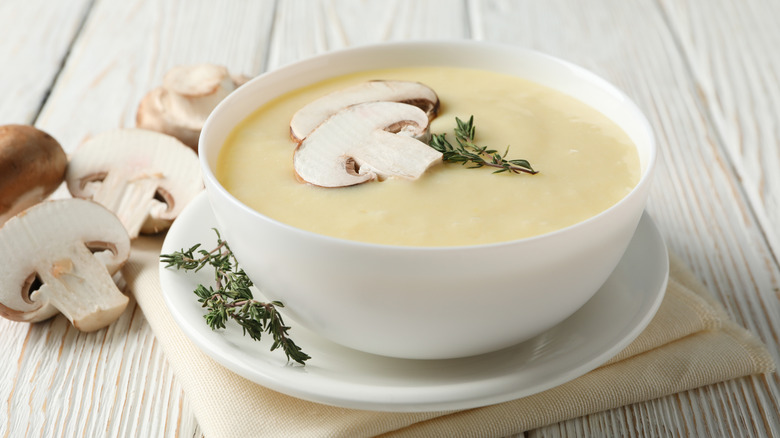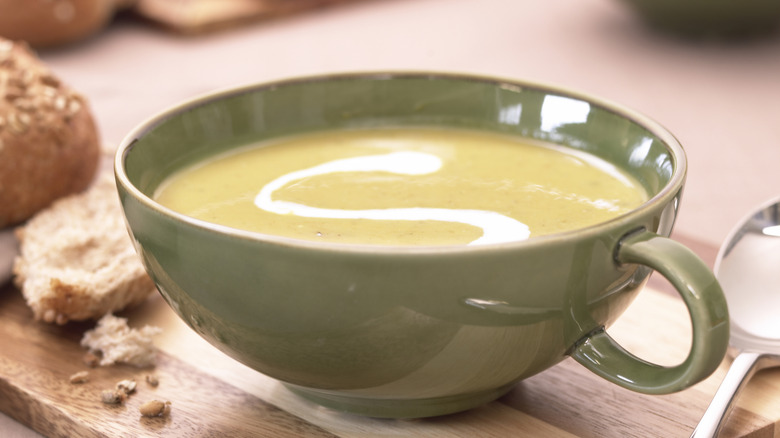What Does It Mean When Soup Is Condensed?
As awesome as a bowl of homemade chicken noodle soup is, not everyone has the time or the energy to cook up a pot when the mood strikes. That's why canned soups have become such a familiar sight in family pantries everywhere — cheap, convenient, and tasty, what's not to like? But if you've ever picked up a can of Campbell's at the store, you've probably wondered once or twice what the "condensed" line emblazoned across the label actually means. Spoiler alert: It's not regular soup.
According to Campbell's website (which proudly stated that they're the first company to make and sell condensed soups), condensed soup is basically regular soup with most of its water content boiled away. The result is a condensed stock that packs the flavor equivalence of two cans of regular soup.
You can eat the soup stock as it is right out of the can, or put it to use as a cooking ingredient in recipes like scalloped potatoes, whose flavor can benefit superbly from soaking up the creaminess of condensed soup. But let's say you want to turn it into a proper bowl of chicken noodle soup. In that case, you have to rehydrate it by adding water, then warm it up over the stovetop. This is why the serving instruction on the label of condensed soups will always be something along the lines of "mix soup + 1 can water"!
Who made the first can of condensed soup?
Campbell's claim to being the first to the market with condensed soup is totally legit. After all, it's through them that they've now become probably one of the most iconic canned soup makers around. The first can of condensed soup could be traced back to John T. Dorrance, a chemist working at his uncle's company, the Joseph Campbell Preserve Company, in the early 1900s. Dorrance had noticed during his time studying in Europe that Americans don't eat nearly as much soup as Europeans, mainly because the available canned soups were bulky, expensive, and didn't last long. If people wanted instant soup, they'd have to use bouillons, which often weren't so delicious.
So, Dorrance got to work and spent a year developing a line of "condensed" soups. By boiling half of the soup's water content, he could cut the weight to make it easier to transport. Later, he found ways for the condensed soups to retain their flavors even after undergoing this treatment.
These lighter soup cans were much cheaper than anything else on the market while being tastier. Unsurprisingly, they became a resounding success that lifted Campbell's out of financial trouble, as well as changing the eating habits of Americans forever. Today, it's hard to imagine a kitchen without a can or two of Campbell's soup tucked away in the pantry!
How to make condensed soup at home
Thinking how nifty it'd be to be able to make condensed soup at home? Good news: you totally can! A custom soup, more often than not, will be tastier than canned. And since you're in charge of the ingredients, you're free to cater to any dietary restrictions or preferences you may have, too.
If you've ever made béchamel sauce for your buttermilk lasagna before, it's pretty much like that. Start by cooking flour and butter together on the stove to create a smooth roux. Then, gradually add broth and milk (dairy or non-dairy are fine), stirring constantly as the mixture reduces and thickens. And there's your basic condensed soup, which you can then season to taste! Use it as a spread, a soup base, or in any recipe calling for condensed soup.
Do note, however, that fresh condensed soup by itself isn't shelf-stable. It'd have to be pressure canned to get the months-long storage life as the ones you find in the supermarket. Still, if you keep it in a jar and refrigerate it properly, it should keep for around three days. So why not give it a try? You might find yourself enjoying the process and far tastier results than anything you could get from a can of soup!


